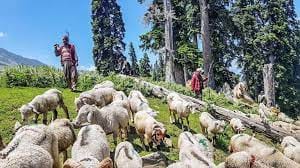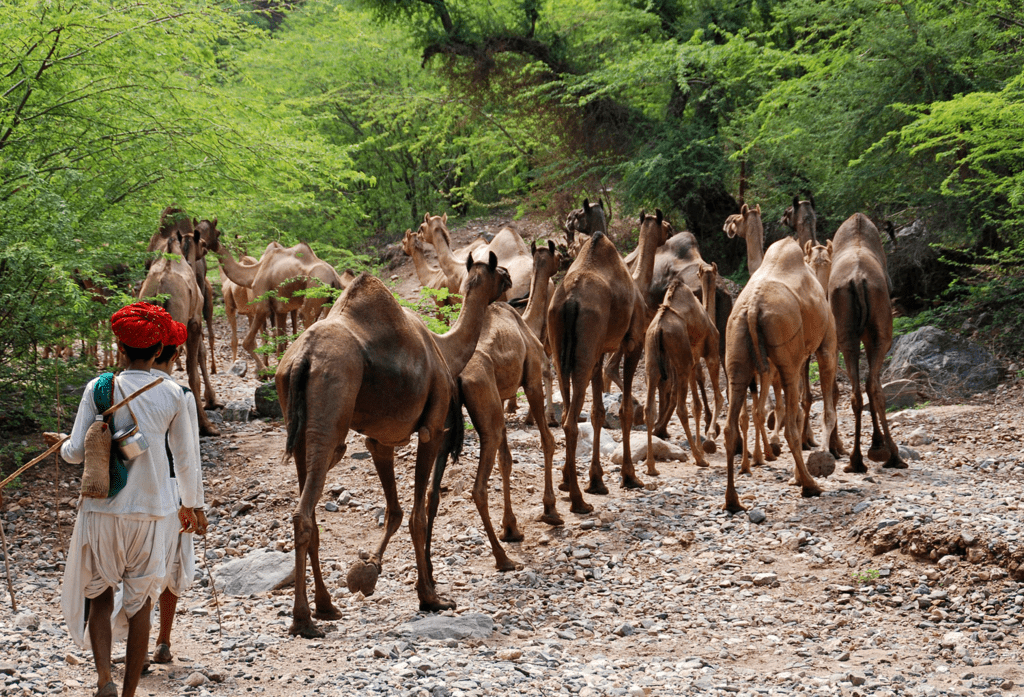Key Concepts - Pastoralists in the modern world | Social Studies (SST) Class 9 PDF Download
| Table of contents |

|
| Introduction |

|
| Mountain Nomads |

|
| Changes in Pastoral Life Due to Colonial Rule |

|
| Pastoralism in Africa |

|
| Glossary and Important Information |

|
Introduction
The "Pastoralists in the Modern World" chapter explores nomadic pastoralists, individuals who lead a mobile lifestyle. Highlighting the influence of pastoralism on societies like India and Africa, the chapter examines the impact of colonialism and how these communities adapt to modern challenges.
Mountain Nomads
Gujjar Bakarwals of Jammu and Kashmir:
- Pastoral nomads in 'Kafila' groups are governed by cold and snow.
- Winter migration to low hills, summer return to lush mountains.
 Gujjar Bakarwals of Jammu and Kashmir
Gujjar Bakarwals of Jammu and Kashmir
Gaddi Shepherds of Himachal Pradesh
- Similar cycle, winter in low Sivalik hills, summer in Lahul and Spiti.
Nomadic Life in Different Regions
Gujjar Cattle Herders of Kumaon and Garhwal
- Summer in 'bugyals,' winter in 'bhabar.'
Bhotias, Sherpas, Kinnauri
- Cyclic movement adapting to seasonal changes and maximizing pastures.

Nomadism on Plateaus, Plains, and Deserts
- Dhangars of Maharashtra: The Dhangars in Maharashtra follow a nomadic pattern, residing in the central plateau during the monsoon and migrating to the Konkan region by October.
- Gollas, Kurumas, Kurubas of Karnataka and Andhra: Communities like Gollas, Kurumas, and Kurubas in Karnataka and Andhra Pradesh exhibit nomadic tendencies, shifting from wooded areas to coastal tracts during dry periods.
- Banjaras of Uttar Pradesh, Punjab, Rajasthan, Madhya Pradesh, Maharashtra: Spread across Uttar Pradesh, Punjab, Rajasthan, Madhya Pradesh, and Maharashtra, the Banjaras lead a nomadic lifestyle, constantly in search of fertile pastures.
- Raikas of Rajasthan: The Raikas in Rajasthan adopt a blended approach, combining cultivation with pastoralism. They move to greener pastures to ensure the well-being of their livestock.
Sustainability of Pastoral Life
- Judicious use of judgment for duration in an area.
- Knowledge of food and water sources.
- Calculations for timings of movement.
- Establishing relationships with farmers for grazing on harvested fields.
Changes in Pastoral Life Due to Colonial Rule
- Decreased grazing grounds, regulated movements, increased revenues.
- Decline in trade, crafts, and agricultural produce.
Coping with changes —
- Some reduced the number of cattle in their herds.
- Some discovered new pastures.
- Some bought land and began to lead a settled life.
- Some poor peasants borrowed money to survive, in due course of time they lost their cattle and sheep and became laborers.
Pastoralism in Africa
The Maasai
- Facing challenges due to loss of grazing grounds.
- Territorial divisions, white settlements, conversion of grazing lands to cultivated land and reserves.
Kaokoland Herders
- Confined to special reserves, restrictions on movement and trade.
The British appointed chiefs to administer the affairs of the tribe. These chiefs were wealthy and lived a settled life as they had both pastoral and non-pastoral income. The poor pastoralists passed through bad times and worked as labourers. There were two important changes :
- the traditional difference between the elders and warriors was disturbed.
- there came to be a marked difference between the rich and poor.
Developments within Pastoral Societies
Pastoralists adapt to new times. They find new pastures, change their routes for their annual movement, reduce their cattle numbers, press for their rights, etc. It is being advocated today that pastoral nomadism is the best form of life suited to the dry, semi-arid and mountainous regions of the world.
Loss of Grazing Lands and Water Resources
- The Maasai faced pressure as their grazing lands and water resources were taken away, leading to a decline in the quality of pastures.
- Continuous grazing within limited areas resulted in fodder shortages, making it difficult to feed the cattle.
Imposition of Restrictions
- In the late 19th century, colonial governments restricted the mobility of pastoralists by confining them to special reserves.
- Pastoralists needed permits to move, and obtaining them was challenging, leading to a loss of freedom of movement.
Impact of Drought
- Drought is a common challenge for pastoralists, and traditionally, nomadism allowed them to cope by moving to areas with available forage.
- However, colonial restrictions confined the Maasai to fixed areas, making it difficult to avoid the adverse effects of drought. Many cattle died during severe droughts.
Social Changes
- Traditional Maasai society was divided into elders and warriors. The colonial government appointed chiefs, disrupting the traditional authority of both groups.
- Chiefs often accumulated wealth and engaged in trade, while poor pastoralists struggled during crises, losing their livestock and turning to menial jobs.
Adaptation and Challenges
- Despite challenges, pastoralists adapted by changing movement patterns, reducing cattle numbers, and seeking political support for rights and relief.
- Pastoralists are not relics of the past; their nomadic lifestyle is recognized as suitable for certain regions by environmentalists and economists.
Glossary and Important Information
1. Nomads: Nomads are those people who do not live in one place but move from one area to another to earn their living.
2. Bhabar: A dry forested area below the foothills of Garhwal and Kumaon.
3. Bugyai: Vast meadows in the high mountains.
4. Kharif: The autumn crop, usually harvested between September and October.
5. Rabi: The spring crop, usually harvested after March.
6. Stubble: Lower ends of grain stalks left in the ground after harvesting.
7. Pasture: It is grass or other plants grown for feeding or grazing animals, as well as land used for grazing.
8. Massai: A pastoralist community of Africa.
9. Criminal Tribes Act: In 1871, the colonial government in India passed the Criminal Tribes Act. By this Act, many communities of craftsmen, traders and pastoralists were classified as criminal Tribes.
10. Customary Rights: Rights that people are used to by custom and tradition.
tradition.
|
55 videos|635 docs|79 tests
|
FAQs on Key Concepts - Pastoralists in the modern world - Social Studies (SST) Class 9
| 1. How did colonial rule impact pastoral life in Africa? |  |
| 2. What is pastoralism in Africa? |  |
| 3. What were some of the changes in pastoral life brought about by colonial rule? |  |
| 4. How did the imposition of taxes affect pastoralists under colonial rule? |  |
| 5. Why did conflicts arise between pastoralists and agricultural communities under colonial rule? |  |
















